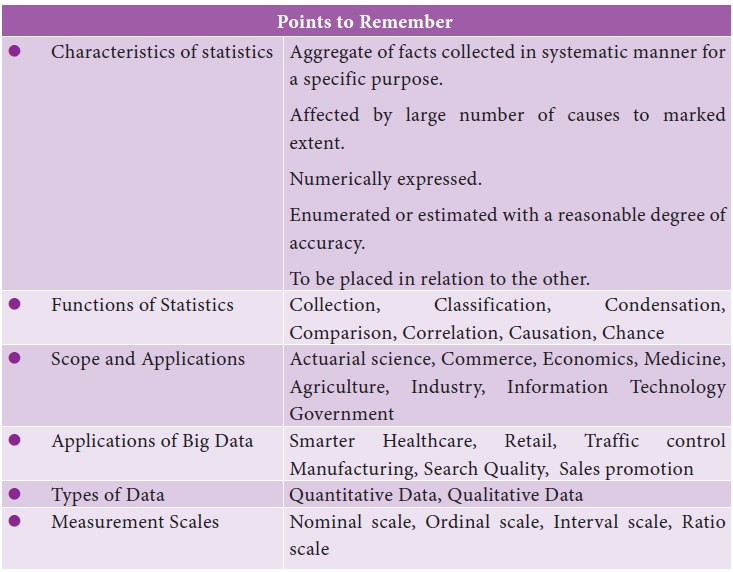Statistics - Measurement Scales | 11th Statistics : Chapter 1 : Scope of Statistics and Types of Data
Chapter: 11th Statistics : Chapter 1 : Scope of Statistics and Types of Data
Measurement Scales
Measurement
Scales
There
are four types of data or measurements scales called nominal, ordinal, interval
and ratio. These measurement scale is made by Stanley Stevens.
Nominal scales:
Nominal
measurement is used to label a variable without any ordered value. For example,
we can ask in a questionnaire ‘What is your gender? The answer is male or female. Here gender is a nominal variable and we associate
a value 1 for male and 2 for a female.’
They
are numerical for name sake only. For example, the numbers 1,2,3,4 may be used
to denote a person being single, married, widowed or divorced respectively.
These numbers do not share any of the properties of numbers we deal with in day
to life. We cannot say 4 > 1 or 2 < 3 or 1+3 = 4 etc. The order of
listings in the categories is irrelevant here. Any statistical analysis carried
out with the ordering or with arithmetic operations is meaningless.
Ordinal scales:
These
data share some properties of numbers of arithmetic but not all properties.
For
example, we can classify the cars as small, medium and big depending on the
size.
In
the ordinal scales, the order of the values is important but the differences
between each one is unknown. Look at the example below.
How
did you feel yesterday after our trip toVedanthangal? The answers would be:
(1)
Very unhappy (2) Unhappy (3) Okay (4)
Happy (5) Very happy
In
each case, we know that number 5 is better than number 4 or number 3, but we
don’t know how much better it is. For example, is the difference between “Okay”
and “Unhappy” the same as the difference between “Very Happy” and “Happy?” In
fact we cannot say anything.
Similarly, a
medical practitioner can
say the condition of a patient in
the hospital as good,
fair, serious and critical and assign numbers 1 for good, 2 for fair, 3 for
serious and 4 for critical. The level of seriousness can be from 1 to 4 leading to 1 <
2 or 2 < 3 or 3 < 4. However, the value here just indicates the level of
seriousness of the patient only.
Interval scales:
In
an interval scale one can also carryout numerical differences but not the
multiplication and division. In other words, an interval variable has the numerical distances between any two numbers. For example, suppose we are
given the following
temperature readings in
Fahrenheit: 60c , 65c , 88c , 105c , 115c , and 120c. It can be written that
105c> 88cor 60c < 65c which means that 105cis warmer than 88c and that
60c is colder than 65c. It can also be written that 65c– 60c = 120c - 115c
because equal temperature differences are equal conveying the same amount of
heat needed to increase the temperature from an object from 60c to 65c and from
115c to 125c. However it does not mean that an object with temperature 120c is
twice as hot as an object with temperature 60c, though 120c divided by 60c is
2. The reason is converting the temperature in to Celsius we have:

In
the above equations, it is clear from the left hand side that 120cF is twice of
60cF while the right hand side says 48.87cC is more than three times of 15.57cC
. The reason for the difficulty is that the Fahrenheit and Celsius scales have
artificial origins namely zeros(freezing point of centigrade measure is 0o C and the freezing point of Farenheit is 32o F) and there is no such thing as ‘no temperature.’
Ratio scales:
Ratio scales are important when it comes to measurement scales
because they tell us about the order, they tell us the exact value between
units, and they also have an absolute zero–which allows for a wide range of
both descriptive and inferential statistics to be applied. Good examples of
ratio variables include height and weight. Ratio scales provide a wealth of
possibilities when it comes to statistical analysis. These variables can be
meaningfully added, subtracted, multiplied, divided). Central tendency can
be measured by mean,
median, or mode; Measures of dispersion, such as standard deviation and
coefficient of variation can also be calculated from ratio scales.
In summary, nominal variables are used to “name,” or label a
series of values. Ordinal scales provide good information about the order of
choices, such as in a customer satisfaction survey. Interval scales give us the
order of values plus the ability to quantify the difference between each one.
Finally, Ratio scales give us the ultimate–order, interval values, plus the
ability to calculate ratios since a “true zero” can be defined. The distinction
made here among nominal, ordinal, interval and ratio data are very much important
as these concepts used in computers for solving statistical problems using
statistical packages like SPSS, SAS, R, STATA etc.,

Related Topics